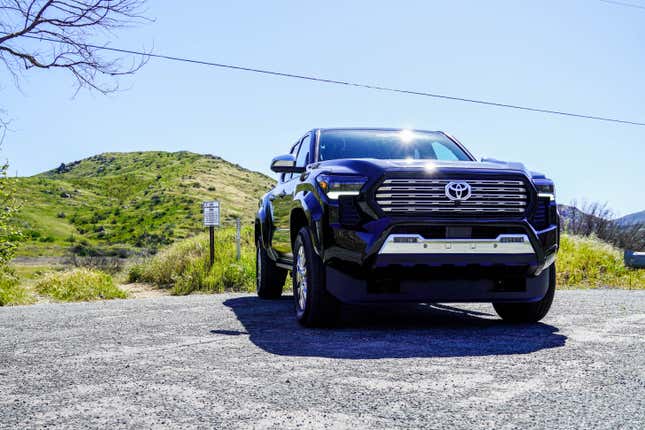
The Taco boasts five different trims that are available with its hybrid powertrain: TRD Sport, TRD Off-Road, Limited, Trailhunter, and TRD Pro. The Limited, seen above, is the only trim more designed for on-road driving than off-road rambling.


The Taco boasts five different trims that are available with its hybrid powertrain: TRD Sport, TRD Off-Road, Limited, Trailhunter, and TRD Pro. The Limited, seen above, is the only trim more designed for on-road driving than off-road rambling.

SAN DIEGO — The 2024 Toyota Tacoma TRD Pro presents a lot of things to talk about, but No. 1 has to be the seats, right? In case you haven’t seen them, the “IsoDynamic” seats in the new TRD Pro have two red shocks on the back, complete with little pressure gauges, in a serious-looking frame with carbon trim and exposed hex bolts. They look incredibly cool; I can totally see someone paying extra for the TRD Pro just to have a truck with seats that look like that. But, they’re a gimmick, right? How much can they possibly do?
Quick answer: Definitely not a gimmick and they actually do quite a lot, even if you don’t realize it, while driving both off- and on-road. How exactly? Each pressurized air reservoir pushes down on oil-filled shocks – one pairing for vertical movement, the other for horizontal movement. A little hand-operated air pump lets you set the air pressure for each reservoir; this can be based on a recommendation from a Toyota app (enter your weight plus the type of off-roading that will be done) or by the old-school method of seeing how much a little rubber O-ring moved during your last off-road foray. There are then little switches at the bottom of each reservoir labeled with on- and off-road icons, but effectively, “on-road” switches the system off by making everything rigid.
I kept them on during my on-road drive from San Diego to the off-road playground the TRD Pro would be more completely tested at (to be fully accurate, I didn’t actually know at the time they could be turned “off”). My first impression of the drive was the TRD Pro had a much better ride than the TRD Off-Road I drove the day prior, or, more specifically, it didn’t suffer from the same wiggling and jiggling over bumps indicative of a body-on-frame vehicle. I initially chalked this up to the TRD Pro’s Fox QS3 Internal Bypass Shocks that are specifically designed to cushion the blow of landing this sucker back down on Earth. But then I drove the TRD Pro on a pock-marked, rock-strewn disaster of a road at 40 miles per hour before launching it airborne. Not only was my landing surprisingly cushioned (what you’d expect those seats to accomplish), I wasn’t violently vibrating with the rest of the truck and my vision was clear. That is what these seats do, and it’s incredible. And don’t just take my word for it.
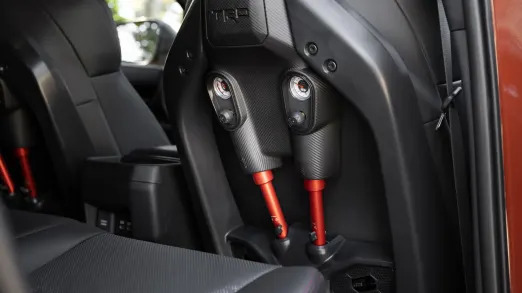
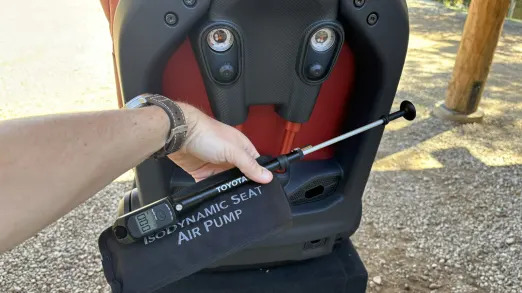

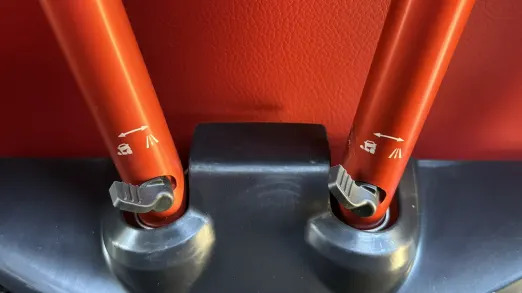
Les Betchner was one of the off-road driving experts on hand to make sure journalists wouldn’t do anything stupid, while also egging on others (this guy) to gun it on a pock-marked, rock-strewn disaster of a road with a looming jump.
“You can carry on a conversation over the roughest bits of road with them, but no way without. There’d be too much vibration,” he said, literally proving the point while we traversed an off-road trail. He also said there’s a huge difference over jumps/landings and big whoops. “Normal seat springs can’t possibly absorb that energy, but the big shocks can.”
The one downside is the seats are incredibly thick, reducing legroom in a back seat that was hardly spacious to begin with. Otherwise, totally positive. Available in a choice of red or black leather, both with the TRD Pro’s unique camo print, they’re actually incredibly snug, supportive and really comfortable even if you turn the shocks to their on-road “off” position. Should you, though? Tacoma chief engineer Sheldon Brown said he keeps the vertical shock “on” while out in the real world, but noted that sometimes leaving the horizontal shock “on” can make it feel like your seat is scooting a bit in certain situations, like a cloverleaf on-ramp. Either way, you can literally just reach behind you and turn the switches.
That’s not the only manually operated switch aboard the 2024 TRD Pro that makes for more customized off-roading. Take a look under the front suspension, and you’ll notice the little knob poking out from those Fox QS3 shocks you can turn to levels 1, 2 or 3. This “Quick Switch 3” manual adjustment of compression damping basically lets you set the firmness of the shocks to match the terrain. Chief engineer Brown said his on-road suggestion is Level 1, while our whole day of off-roading (including that jump) was accomplished with Level 2. He said Level 3 is “for serious compression,” which is obviously more than the 2 feet of air I got. Yee haw.
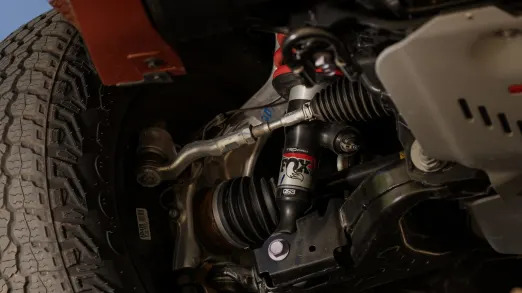


Both the seats and the suspension speak to the new TRD Pro’s added emphasis on being a high-speed desert runner – Toyota’s answer to the Ranger Raptor, if you will. What’s under that bulging hood underlines that point. Standard is the i-Force Max hybrid powertrain that sandwiches a 48-horsepower electric motor between a 2.4-liter turbocharged inline-four and eight-speed automatic transmission. Combined output is 326 hp and 465 pound-feet of torque, which Toyota notes is a 75% torque increase over the old Taco’s weak-sauce V6. It’s also 35 more pound-feet than the Ranger Raptor’s turbo V6, even if the Ford has a cool 79-horse advantage. I didn’t drive them back-to-back, but I have driven both. If the Ford is quicker, I doubt it’ll be by much. The TRD Pro’s hybrid powertrain is every bit the performance engine, and it sounds cooler, too. The added TRD performance air intake and cat-back, dual-tipped exhaust make it sound mean, especially compared to the same powertrain in the TRD Off-Road (where it’s an option). It also doesn’t suffer from the same omnipresent and tiresome drone of the old TRD Pro exhaust. There’s still some four-cylinder buzz, but if you’d rather have the old V6 than this, you’re nuts.
Other elements included with the TRD Pro are the new, manually disconnecting front stabilizer bar (which increases suspension articulation while rock crawling), Fox External Floating Piston rear bump stops (more landing gear), 33-inch Goodyear Territory Rugged-Terrain tires wrapping 18-inch black alloy wheels (these were surprisingly quiet on-road), an electronic locking rear differential (the TRD Off-Road gets this, too), a 20-inch light bar integrated into the front fascia, and a rear bumper and tow hooks sourced from ARB. The suspension upgrades and big tires also contribute to Tacoma-best clearances of 35.7-degree approach, 24.6-degree breakover, 22.6-degree departure and 11.5 inches of running ground clearance.
While the TRD Pro sends itself in the direction of high-speed desert running, Toyota has introduced the 2024 Tacoma Trailhunter for those more interested in rock crawling and overlanding in particular. It too comes standard with the high-powered hybrid, locking rear diff, disconnecting stabilizer bar and 33-inch tires (albeit on extremely cool bronze wheels that match the truck’s TOYOTA badging up front), but differs with its suspension. It gets bespoke Old Man Emu (OME) position-sensitive forged monotube shocks with remote reservoirs tuned to accept greater weight while off-roading (overlanders carry a lot of stuff) and provide greater control in rockier events. It also gets unique rock rails and high-strength steel skid plates, its own steel rear bumper and hooks, and, most obviously, the “sport bar” arching over the bed with removable MOLLE panels. That’s the Trailhunter’s answer to the TRD Pro’s “I want that!” Isodynamic seats. And no, you can’t get those on the Trailhunter. I would think customers might demand that change and, personally, I think they’d still look cool in the Trailhunter’s exclusive “Mineral” green interior color.
While the TRD Pro is offered with a 5-foot bed only, the Trailhunter gets the option of 5- or 6-foot beds. And while the long bed reduces breakover, its increased bed space satisfies the truck’s overlanding mission. In short, you don’t have to be short to sleep in it or above it while camping.
Not surprisingly, the Trailhunter proved more than capable of traversing the rugged off-roading course Toyota created for the press launch. Its disconnecting stabilizer bar helped the tires maintain contact with the ground while also keeping the truck more level over severe one-side-up, one-side-down events. I didn’t drive the TRD Pro on the same course, though, nor did I drive any rival truck. I also can’t say the course was especially gnarly – I did it in Land Cruisers the day before.

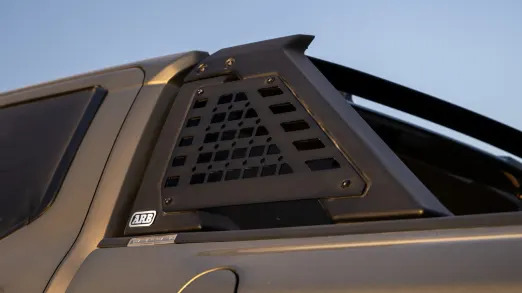

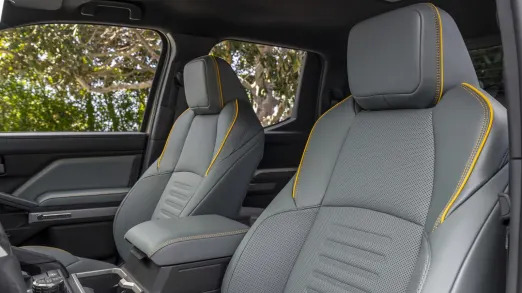
The on-road drive was actually more telling. There was indeed more wiggling and jiggling without the fancy seats, but the Tacoma Trailhunter is still a nice riding truck with a tidy size better suited to more congested suburban roads and highways. Once again, the power on tap impressed, but while the TRD Pro provides some audible sizzle with its TRD intake and exhaust, the Trailhunter has something entirely different. You’ve probably noticed the factory-installed, low-profile secondary air intake attached to the passenger-side A pillar. People often call these snorkels – this was the first vehicle I’ve driven with one and, sure enough, it literally sounds like air being sucked into a snorkel. I found it quite amusing, especially with the passenger window down (your passenger may not appreciate this). There’s a delightful mixture of whooshing and suction noises as you go on and off the throttle. Hmm, maybe this is the Trailhunter’s “I want that” feature.
Either way, it’s easy to see that the Tacoma’s enormous fan club is going to grow, or at least become even more devoted with the introduction of the Trailhunter and the TRD Pro’s serious enhancements. They are cooler and more capable from the get-go, limiting the amount owners will need to fork over to aftermarket outfitters. Of course, they’ll be forking over plenty to Toyota instead, with the Trailhunter starting at $62,900 and the TRD Pro at $63,400. These are comparable to a Chevy Colorado ZR2 Bison, but several thousand more than the lesser ZR2 as well as the Ranger Raptor.
There’s also still plenty left to customize, and indeed chief engineer Brown said he thinks it’s a positive that Tacoma buyers want to take their trucks in a different and/or more extreme direction. That’s one of the reasons his team went with the manually disconnecting stabilizer bar instead of the more complex KDSS automatically disconnecting system found in the old 4Runner that, while arguably more capable, makes it harder to modify the suspension.
Have it your way, as the Burger King would say. But if you want those seats – and believe me, you want those seats – the way you want probably starts with the TRD Pro.
Related video:

Do you want to go fast or go far? That’s the question Toyota Tacoma Chief Engineer Sheldon Brown posed when I asked how someone chooses whether to buy the 2024 Toyota Tacoma TRD Pro or Tacoma Trailhunter. Another question worth asking is, how much is in your budget?
Toyota’s off-road Tacoma flagship has been split in two, each with its own personality. The TRD Pro is meant to go fast over sand and dirt, while the Trailhunter is built to crawl over off-road obstacles.
The outgoing Tacoma TRD Pro was meant to be the do-everything Swiss Army knife of midsize pickup trucks, Brown explained. However, trying to be good at everything often makes a product mediocre at most things.
After spending time behind the wheel of both the 2024 Toyota Tacoma TRD Pro and Tacoma Trailhunter pickups, it’s clear the automaker focused each truck on its dedicated mission. However, neither truck is the off-road king of the hill.
Let’s go off-pavement and dig in.
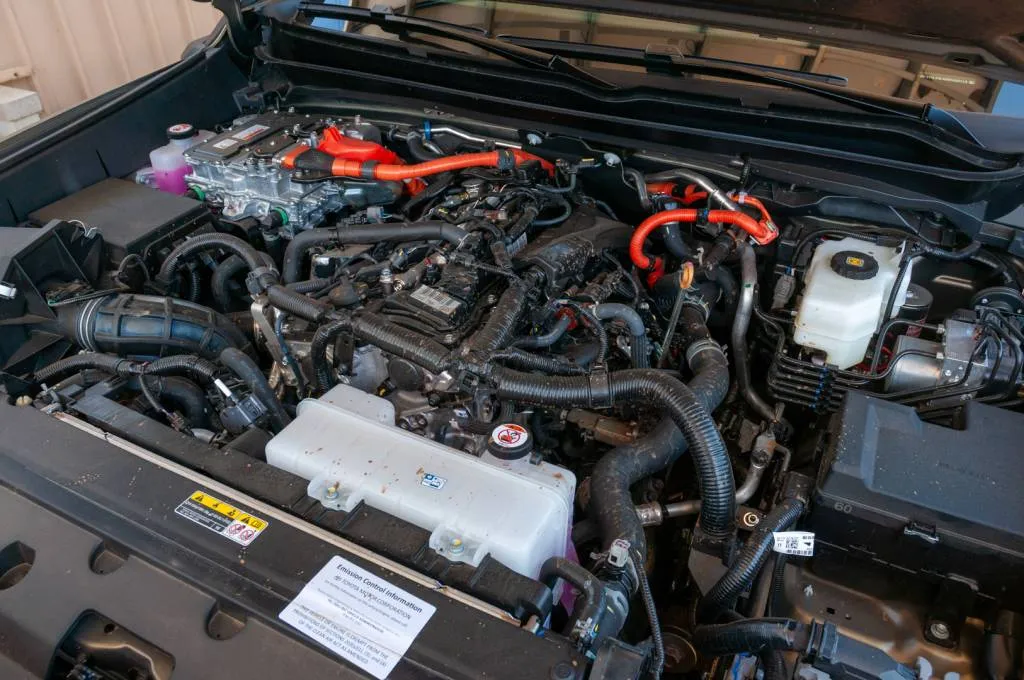
2024 Toyota Tacoma Trailhunter
Every Tacoma TRD Pro and Trailhunter pickup is a hybrid. RIP to the old V-6.
Under the hood sits a 2.4-liter turbo-4 mated to an electric motor located in the 8-speed automatic transmission. Total output checks in at 326 hp and 465 lb-ft of torque. On paper those numbers outgun the Chevrolet Colorado ZR2 turbo-4’s 310 hp and 430 lb-ft. The Toyota also bests the Ford Ranger Raptor’s 430 lb-ft of torque rating, but falls short of beating the Raptor’s 405 hp number.
The hybrid system provides only decent fuel economy numbers at 22 mpg city, 24 highway, and 23 combined for both trucks. I didn’t get to drive these trucks on pavement, so I can’t comment on real-world fuel economy.
I did experience this powertrain on-road in a Tacoma Limited model lined with leather. Like other Hybrid Max-badged Toyotas, the hybrid powertrain is strong, but somewhat underwhelming, with no wallop of power off the line or on the highway despite the high torque number.
Off-road, the story is different, though it’s still a mixed bag. The electric motor contributes to immediate torque that provides plenty of grunt at low speeds and when crawling in the Trailhunter. Power delivery is smooth, as expected because Toyota has become the leader at hybrid power blending.
In the TRD Pro, however, once the electric motor’s boost trails off the turbo-4 simply doesn’t deliver the same kick in the pants as the larger 2.7-liter turbo-4 in the Colorado ZR2. Also, no Tacoma offers paddle shifters like the Ranger Raptor. Brown said the team thought about paddle shifters for the TRD Pro, but it wasn’t really sure how many people would use the manual shift capability. I would’ve while driving at high speeds off-road because if programmed correctly it allows for more control to stay in the power band when needed.
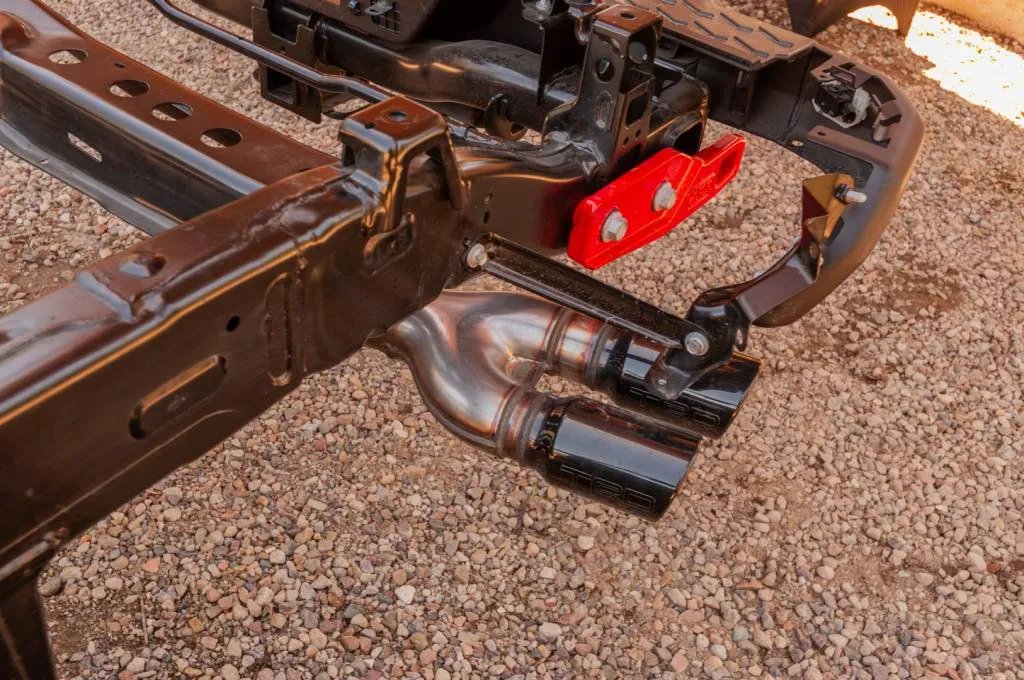
2024 Toyota Tacoma TRD Pro
The turbo-4’s noise, even with the performance exhaust of the Trailhunter and TRD Pro, isn’t in the same class as the throaty high-pitched turbo V-6 burble of the Ranger Raptor. It is notably deep for a turbo-4, though. That’s in part due to the TRD performance cat-back exhaust system. On the Trailhunter, the exhaust dumps out high just in front of the rear axle, where it’s tucked away from to prevent damage. On the TRD Pro, the exhaust splits into two welded black tips that exit on the driver side just behind the rear wheel.
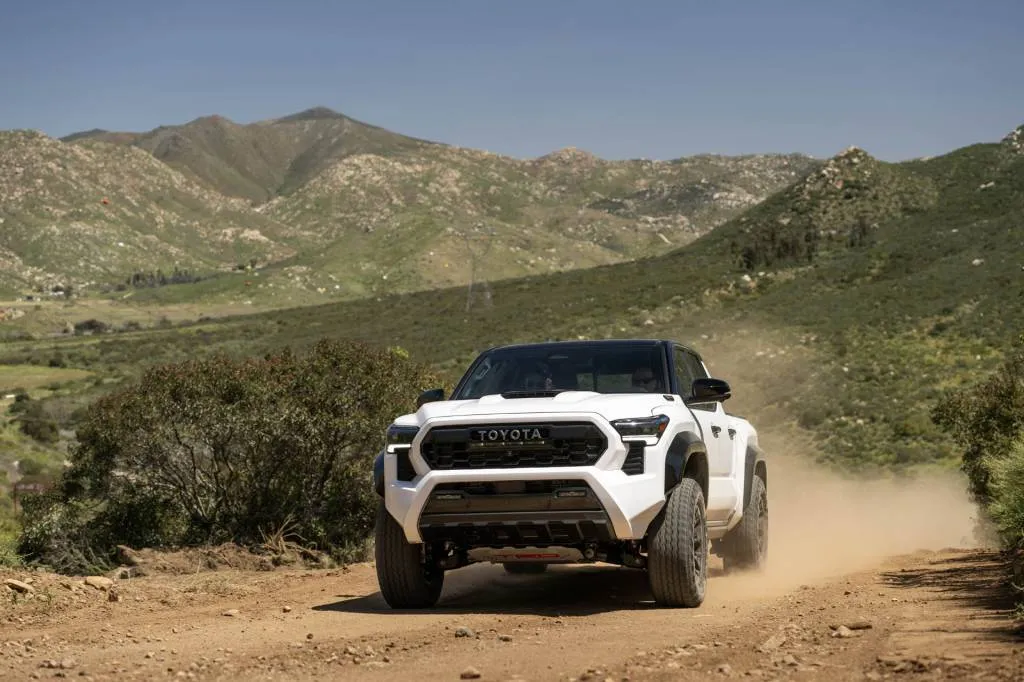
2024 Toyota Tacoma TRD Pro, photo via Nathan Leach-Proffer
In some ways the Tacoma TRD Pro hits the mark and bests the competition, but in many ways it falls short.
The Tacoma TRD Pro can indeed go fast off-road, to a point, as I learned on a bumpy gravel road.
When I pointed the TRD Pro down the rock-strewn gravel fire road, my right-seat companion, Andy, a professional stunt driver, told me to hit the hump in the road at 40 mph. That speed would send the truck flying. Any faster and we might land and bury the nose into the ground, much less and we wouldn’t get the air I wanted. I hit 48 mph before the hump, then lifted as instructed by Andy. Our speed dropped to 36 mph as we crested the hump. The truck took flight for a few feet and landed softly.
“That wasn’t dramatic enough,” I told him, noting we were going to need to do that again.
The front tires hit the hump the second time with the speedometer at 46 mph, a little faster than instructed.
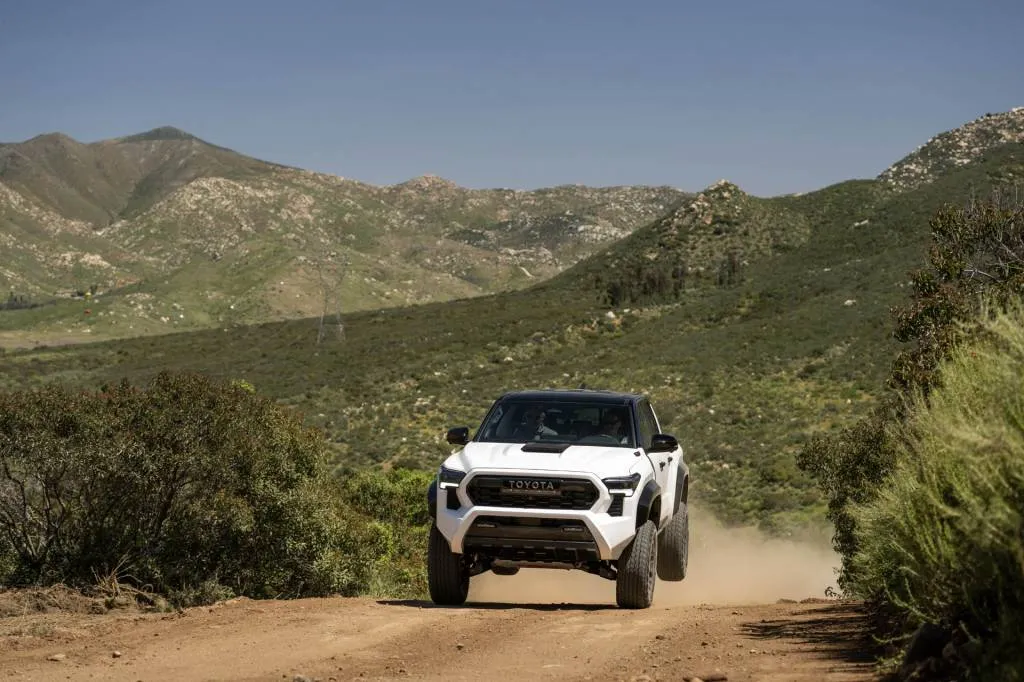
2024 Toyota Tacoma TRD Pro, photo via Nathan Leach-Proffer
When the truck landed the 2.5-inch Fox QX3 shocks with small piggyback remote reservoirs went to nearly full compression and took the hit. I don’t think the rear end hit the hydraulic Fox jounce bumpers (the Trailhunter doesn’t have these), but if they did, they took the blow so well I didn’t even notice.
Andy said I could now go as fast as I could comfortably see down the rest of the fire road. He was wrong. With the pedal buried I soon realized the truck was about to rattle apart if it went much faster. The shocks weren’t keeping up with all the bumps. I didn’t see my speed because I was watching for rocks so I wouldn’t blow apart the underside of the truck (been there, done that, sorry, Chevy). The hood was shaking so violently that I let off the throttle a bit. I could’ve gone faster, the truck I’m not so sure.
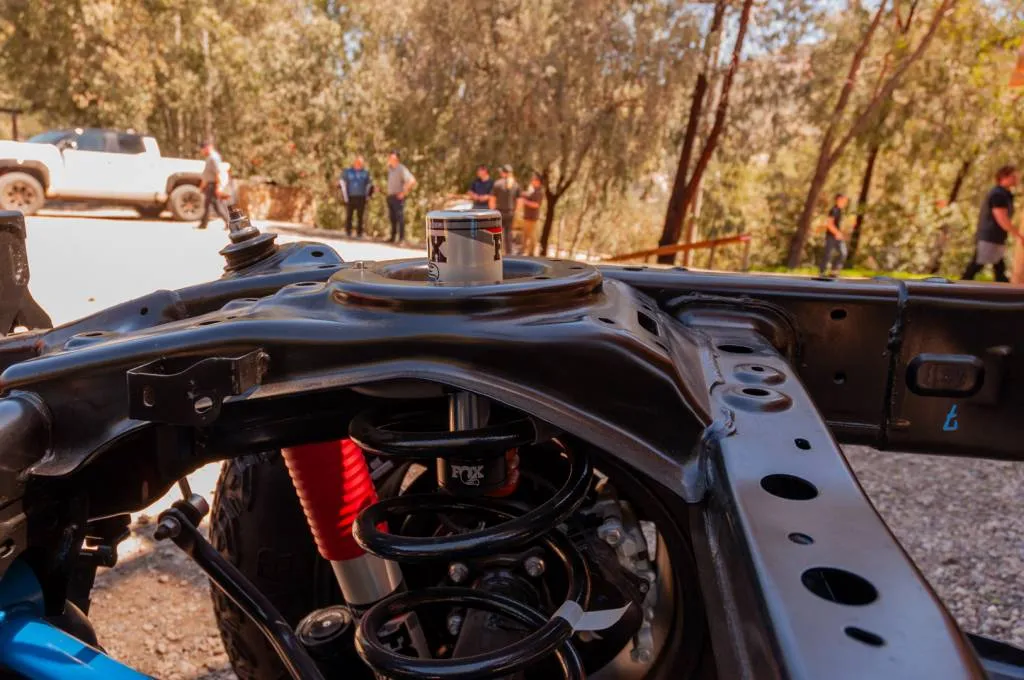
2024 Toyota Tacoma TRD Pro
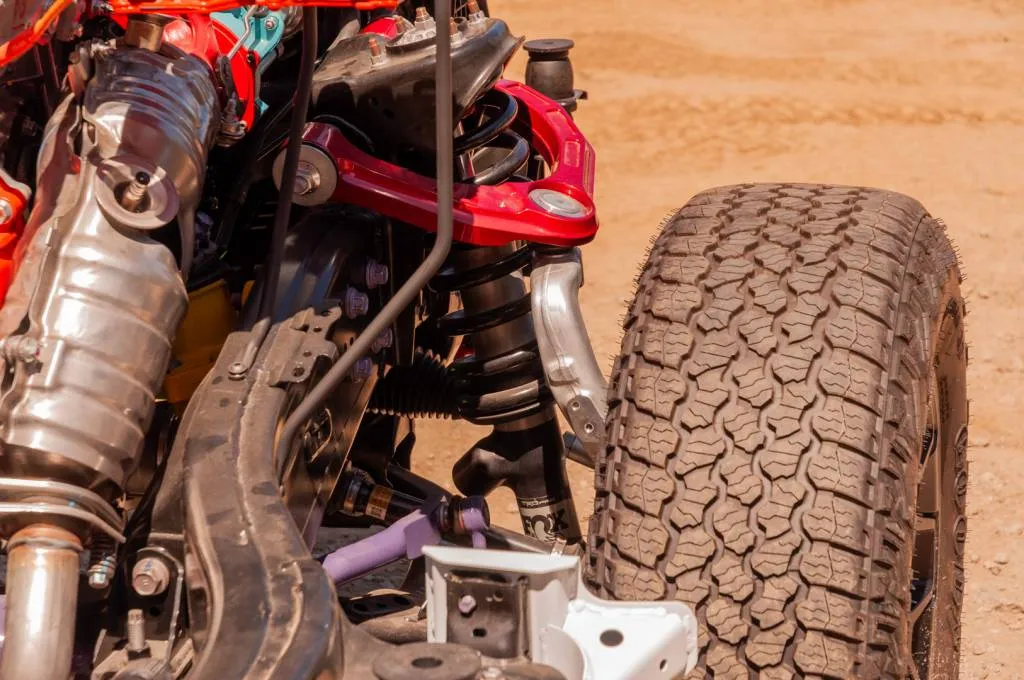
2024 Toyota Tacoma TRD Pro
Brown told me the three-way adjustable Fox shocks were set to level two. Level one is for road use. Level two is for fire roads, which is what we were on. Level three is meant for desert-style Baja driving with more compression damping. Apparently, I can see at Baja-level speeds. Brown noted that if he had known someone would be willing to go that fast down the fire road he would’ve switched the shocks to level three. Next time, Brown.
The TRD Pro’s steering weight was nearly ideal as I didn’t have to saw back and forth on the thick perforated TRD-branded steering wheel to keep the truck going straight.
Based on my time with both the Colorado ZR2 and Ranger Raptor, both trucks would have gone faster on the fire road, at least with the Tacoma’s Fox QS3 shocks set to Level 2. Unlike the TRD Pro, those trucks also don’t require a driver to manually turn a knob on each shock to adjust them, as the ZR2’s Multimatic DSSV shocks constantly adjust to conditions while the Raptor’s Fox Live Valve shocks adjust electronically based on the chosen drive mode.
The TRD Pro and Trailhunter are 3.0 inches wider than the base Tacoma SR5, which itself is about 3.0 inches wider than the outgoing SR5 model. With the 33-inch Goodyear Territory R/T tires tucked under the bulging fenders, it’s hulking in comparison to an older Tacoma. Sorry kids, 35s aren’t going to fit without rubbing.
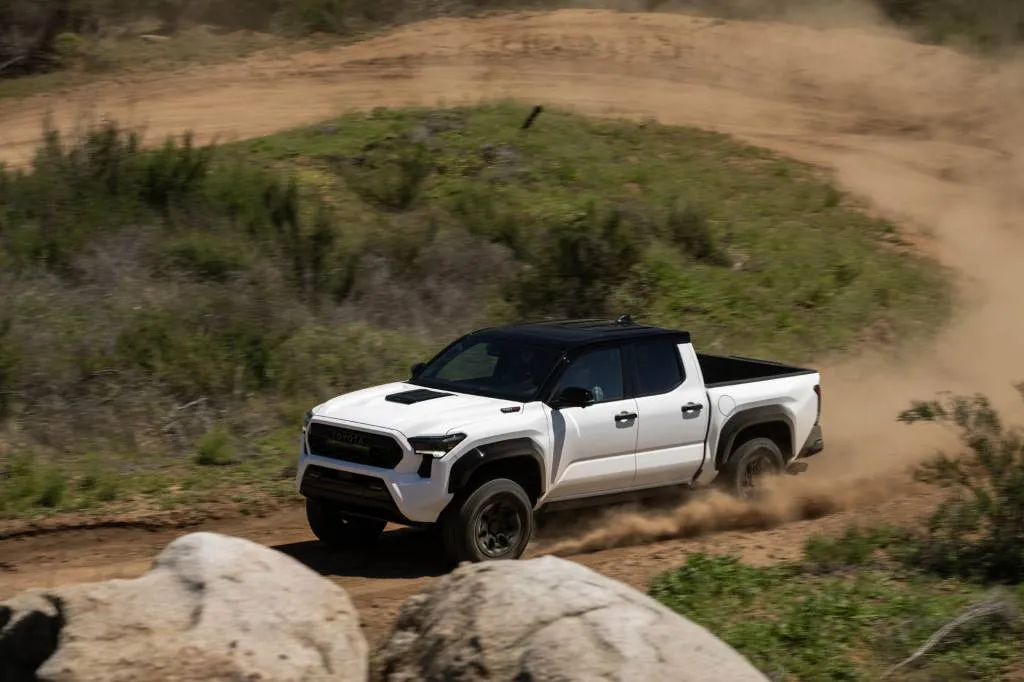
2024 Toyota Tacoma TRD Pro, photo via Nathan Leach-Proffer
That wide stance helped give the TRD Pro a stable feeling while blasting around corners and down straights in the dirt on a motocross course. The new coil-spring rear suspension kept things planted and the tires in contact with the earth for better traction. But full-time four-wheel drive is nowhere to be found unlike on a Colorado ZR2 and Ranger Raptor. That’s just being cheap, Toyota.
The various off-road modes of the Multi-Terrain Select system now work in 4Hi and 4Lo, and the crawl control system, which is like off-road cruise control, no longer clunks and thunks. Still, there’s no Baja mode or anything that truly kicks the TRD Pro’s powertrain in the pants. The off-road drive modes are limited to Mud, Dirt, and Sand. Coming around banked turns on the motorcross course, the powertrain sometimes bogged down and got caught flat footed. The transmission simply didn’t want to shift quickly enough. Can we get a Baja mode, Toyota?

2024 Toyota Tacoma TRD Pro
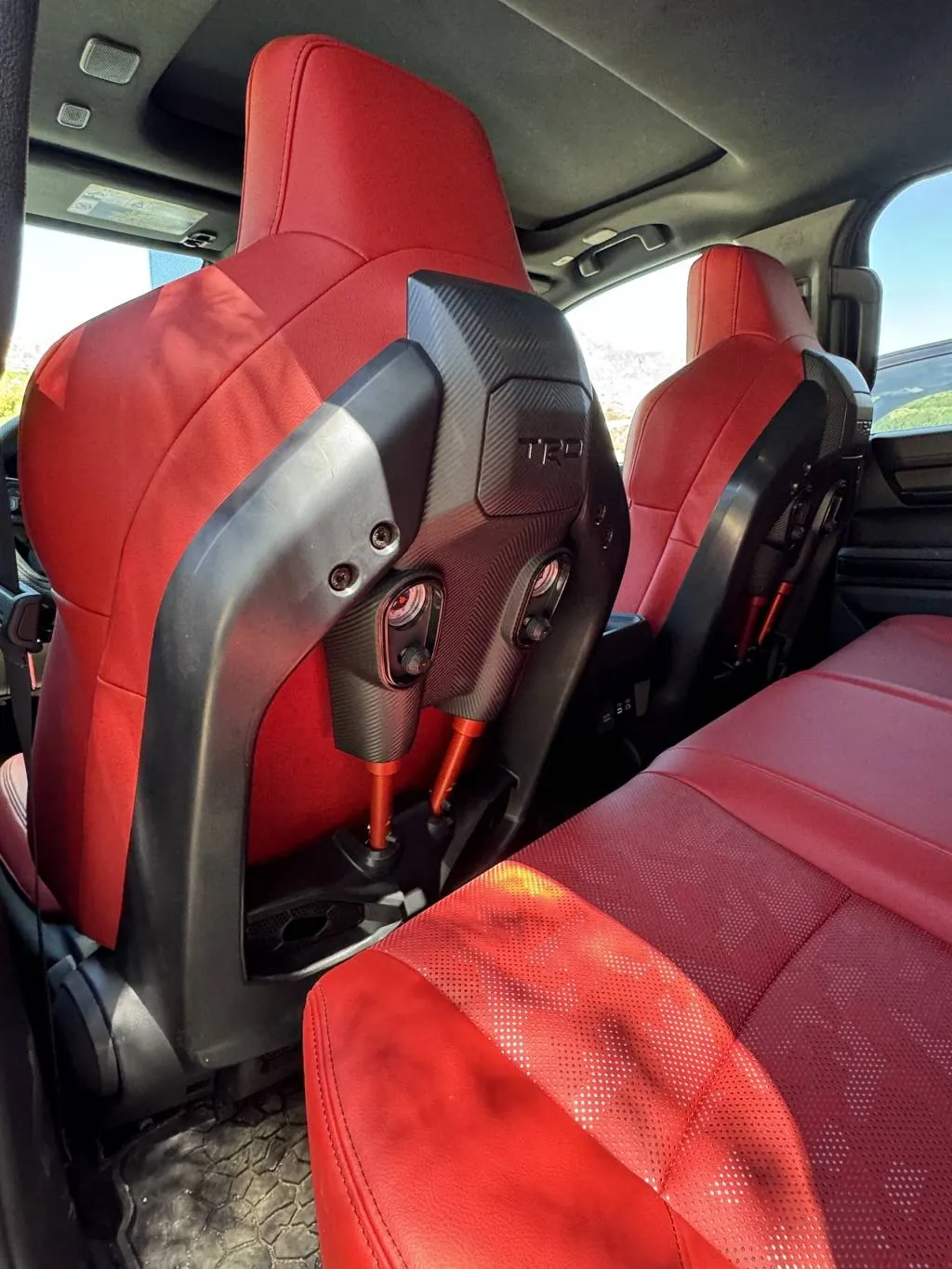
2024 Toyota Tacoma TRD Pro
Inside, the TRD Pro’s cabin is mostly standard Tacoma fare. Chunky knobs and buttons serve as controls ranging from climate and audio functions to off-road features such as the rear locker. However, the front seats boast built-in shock absorbers to help with lateral stabilization while off-roading. They work. With air-pressure adjustments, these seats stabilize the driver’s body during high-speed off-roading for less jostling and fatigue. They might be the best seats in an off-road pickup, certainly in the midsize segment. The downside is the shocks, and their brackets, severely eat into rear seat legroom, taking it to “do I have to sit back there?” status.
In theory, I like the available red and black color schemes, but the required camouflage seat pattern is too Bro Truck for me. I could also do without the TOYOTA name stamped into the passenger side of the dashboard. Brown confirmed this is part of a three-piece molding and removing it would require the entire dashboard’s trim to be swapped out.
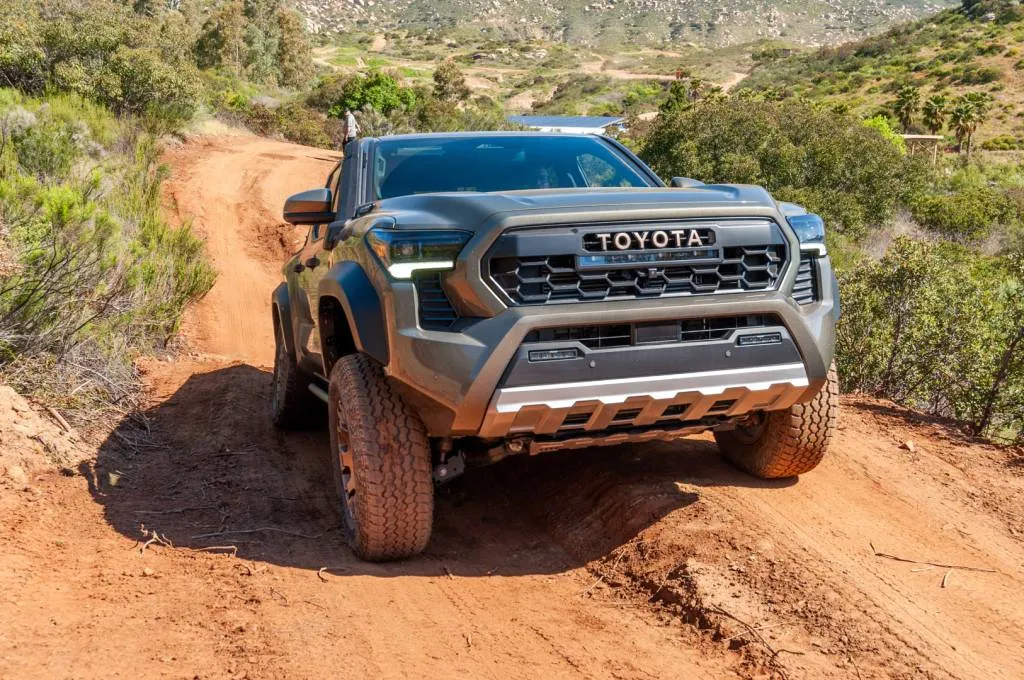
2024 Toyota Tacoma Trailhunter
Trailhunters swap out the TRD Pro’s Fox QS3 shocks for ARB Old Man Emu position-sensitive 2.5-inch shocks with small piggyback remote reservoirs. They are softer than the TRD Pro’s Fox shocks for less jarring movements while clambering over obstacles. I’ll be curious to test both trucks on the road to see the differences on pavement.
No Toyota on the TNGA-F platform (of which the Tacoma shares with the Toyota Land Cruiser, 4Runner, Tundra, Sequoia, Lexus LX and GX) offers a front locker; the chief engineer for the Lexus GX said “we don’t need it.” Maybe, but a Ford Ranger Raptor and Chevrolet Colorado ZR2 both have one.
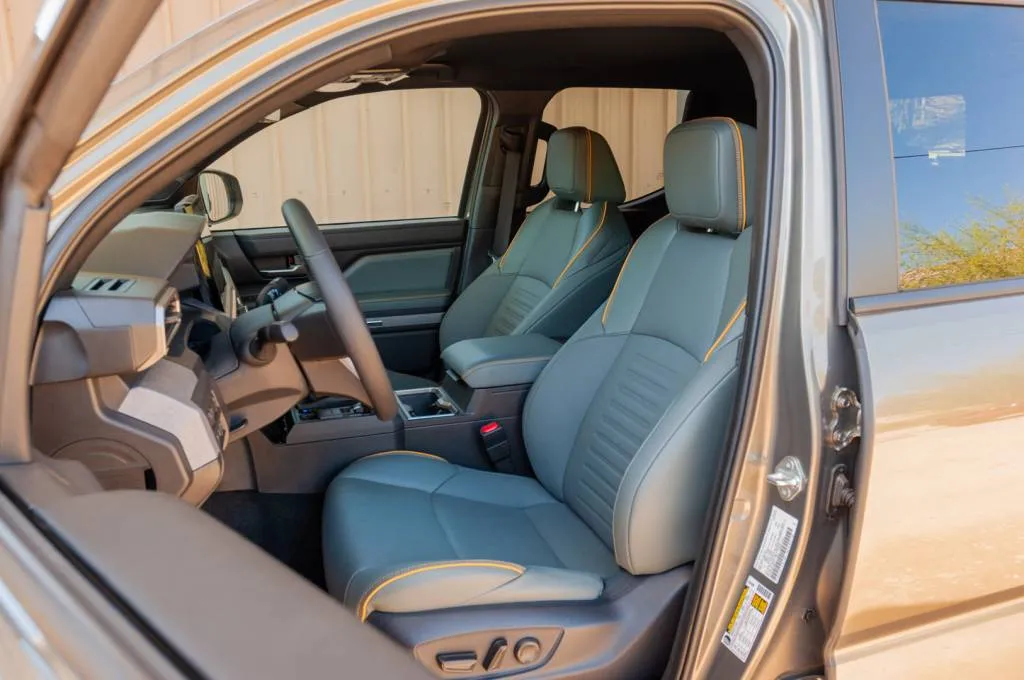
2024 Toyota Tacoma Trailhunter
The Trailhunter trades out the TRD Pro’s fancy front seats for standard Tacoma thrones. My tester’s seats were covered in synthetic leather in a mineral gray color trimmed with gold piping. The material was much more appealing to the eye than the TRD Pro’s camo-covered seats. They also make the rear seat tolerable, though the Colorado ZR2 still has more rear seat space with more comfort. The dashboard trim looks like it was cut out of granite with its matte finish, and the Toyota name is still molded into the passenger side of the dash.
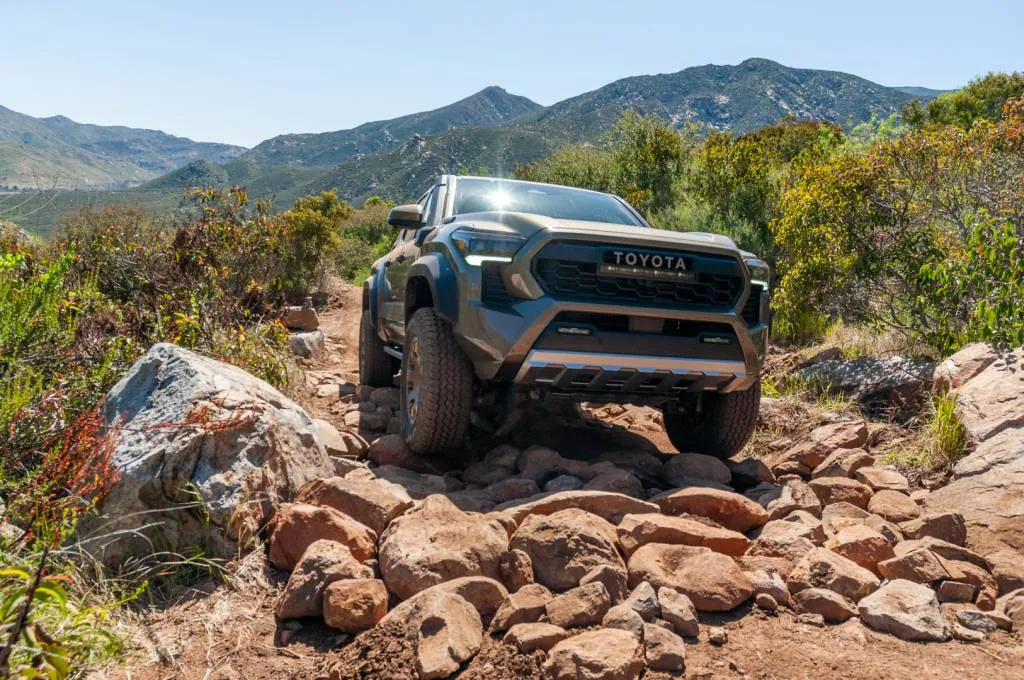
2024 Toyota Tacoma Trailhunter
Both the TRD Pro and Trailhunter only come in four-door crewcab body styles. While each can be had with a 5-foot bed, the Trailhunter is offered with a 6-foot bed for increased cargo capacity for off-road adventures.
Interestingly, the TRD Pro checks in with better off-road angles with 11.5 inches of ground clearance, a 35.7-degree approach angle, a 25.3-degree departure angle, and a 27.4-degree breakover angle. Those numbers eclipse the Trailhunter’s 11.0 inches of ground clearance, 35.2-degree approach, 22.3-degree departure, and 24.0-degree breakover angle.
Should a miscalculation be made when off-roading, the TRD Pro features 6-mm thick aluminum skid plates from the front end to the back of the engine. The Trailhunter upgrades these skid plates as they are made from high-tensile steel. Trailhunters also get a front skid plate that goes to the back of the engine, and adds skid plates for the transfer case, transmission, and rear differential. Both models feature a resin shield around the fuel tank.
Both the TRD Pro and Trailhunter come standard with an electronically disconnecting front sway bar for more suspension articulation. A touch of a button helps keep the front tires in contact with the earth. Ford and Chevy lack this neat feature.
Both trucks are rated to tow up to 6,000 pounds with the 5-foot bed, and the Trailhunter’s optional 6-foot bed drops towing capacity slightly to 5,950 pounds. Brown told me the Trailhunter will be the better tow vehicle as it’ll squat less than the TRD Pro.
The high-speed off-road TRD Pro is rated to haul up to 1,675 pounds of payload, while the Trailhunter is only rated to haul up to 1,475 pounds with the 5-foot bed, and that drops to 1,425 with the 6-foot bed.
Payload and towing match or best the competition. The Colorado ZR2 checks in with a tow rating of 6,000 pounds and is rated to haul up to 1,280 pounds of payload. The Ford Ranger Raptor is rated to tow up to 5,510 pounds and haul up to 1,375 pounds.
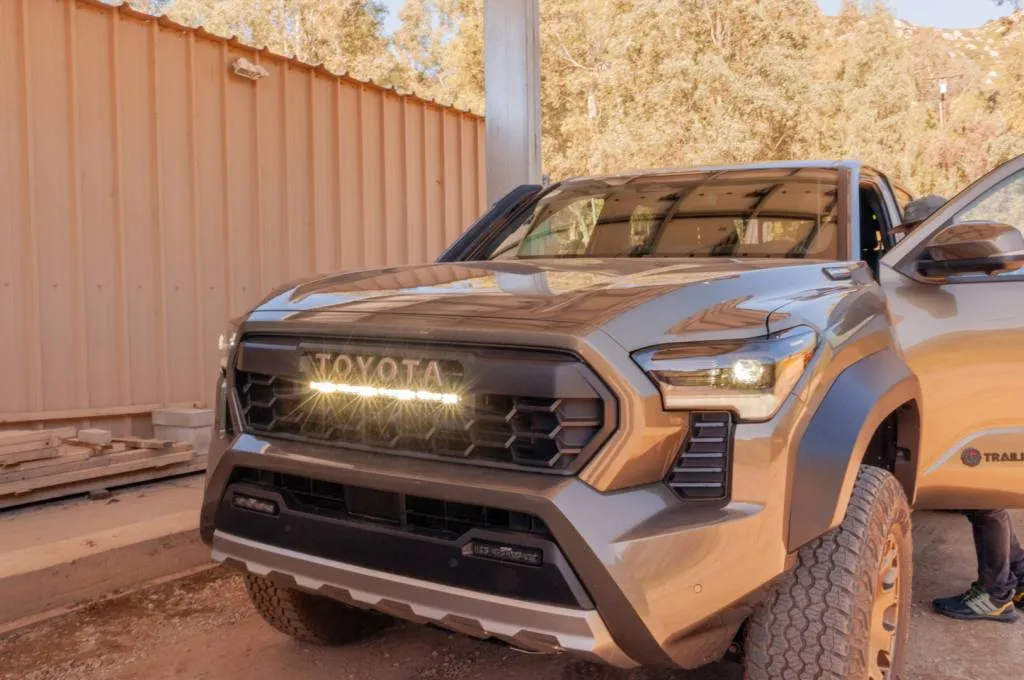
2024 Toyota Tacoma Trailhunter
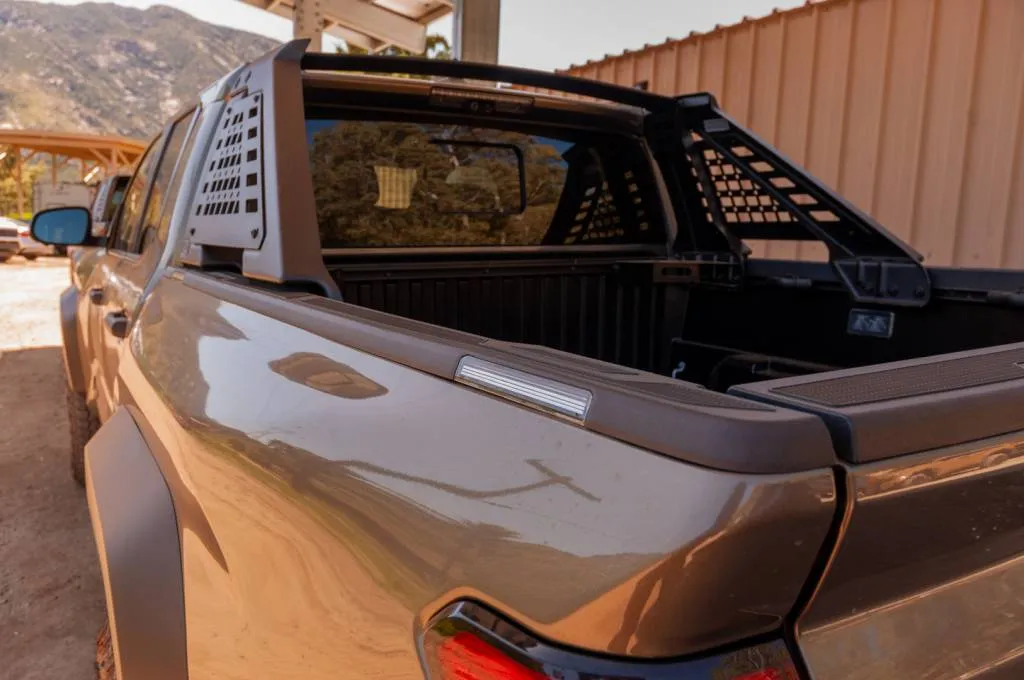
2024 Toyota Tacoma Trailhunter
Both the Tacoma TRD Pro and Trailhunter include lightbars mounted in their grilles, but unlike the Tundra and Sequoia TRD Pros these lightbars will be more functional. The lightbars on the full-size vehicles only put out about 5,000 lumens. An $80 flashlight can create more light output than that. The lightbars on the Tacoma models have a 10,000-lumen rating. It was daytime when I drove the trucks, so judgment day will come later.
Both off-roaders feature LED driving lights mounted in their front bumpers, but the Trailhunter’s setup, provided by Rigid, can switch between cool white or amber. Neat trick. Trailhunter trucks also have white lights mounted on the bed rails that come on with the interior access lights. An ARB sport bar is mounted to the front of the bed with Molle panels to mount off-road gear. It’s a neat bit no other competitor has and it provides real functionality.

2024 Toyota Tacoma TRD Pro, photo via Nathan Leach-Proffer
Value isn’t baked into the Tacoma TRD Pro or the Tacoma Trailhunter.
The Tacoma Trailhunter costs $64,395 including $1,495 destination charge with the 5-foot bed, and another $500 should you opt for the 6-foot bed. The Tacoma TRD Pro costs even more at $65,395.
Those prices make the Chevrolet Colorado ZR2 look like an absolute steal at $48,790, and the Ford Ranger Raptor seem reasonable at $57,065. Both have front lockers and full-time four-wheel drive that the Toyotas lack.
The 2024 Toyota Tacoma TRD Pro and Tacoma Trailhunter both do a good job of fulfilling their mission. The TRD Pro handles the punishment of fast off-roading, while the Trailhunter is more adept when it comes time to pick your way down a trail.
However, given that the Ford and Chevy have more advanced shocks, full-time four-wheel-drive systems, Baja modes, and they both feel quicker, I’m left wondering how much the Toyota Tacoma name can justify the price premium. Those fancy seats with built-in shock absorbers are fantastic, but not $8,330-$16,605 fantastic.
Toyota paid for travel, lodging, and I got sunburned to bring you this firsthand report.

کیا در حال آماده شدن برای عرضه اولین خودروی تجاری سبک خود است، یک پیکاپ سایز متوسط که تاسمان نام دارد.
قرار است در سال 2025 باشد و کیا این هفته اولین عکس را منتشر کرد. عکس کامیون را با روکشی نشان می دهد که آثار هنری ریچارد بوید دانلوپ را نشان می دهد. این هنرمند استرالیایی در ویدیوی زیر نشان داده شده است، جایی که او الهام بخش پشت بسته بندی را توضیح می دهد.
نمونههای اولیه استتار شدهتر در آزمایشهایی از جمله در جادههای ایالات متحده مشاهده شدهاند. با این حال، مشخص نیست که آیا Tasman در اینجا فروخته می شود یا خیر. با این حال کیا عرضه یک کامیون الکتریکی در ایالات متحده را قبل از سال 2027 تأیید کرده است.
بازارهای تایید شده توسط کیا برای دریافت تاسمان شامل استرالیا، کره و چندین کشور در آفریقا و غرب آسیا است.
تاسمن دارای بدنه کابین خدمه استاندارد و طراحی جعبهای است که به خوبی با خودروهای شاسی بلند متوسط کیا Telluride و EV9 مطابقت دارد. این کامیون طرح جلوپنجره جدیدی را برای این برند ارائه میکند که دارای پنج میله عمودی و در کنار آن چراغهای عمودی مشابه چراغهای تلوراید است. قوس چرخهای گشاد شده و لاستیکهای تمام زمینی نیز سطحی از قابلیت خارج از جاده را نشان میدهند.
انتظار می رود این پلتفرم یک طراحی بدنه روی فریم باشد که احتمالاً با پلتفرم جدیدترین شاسی بلند موهاوی که در خارج از کشور فروخته شده است، مرتبط باشد. چرخهای شش لنگه نیز نسبت به کیا معمولی شما، ناهمواری و قابلیت خارج از جاده را نشان میدهند. شایعات حاکی از ظرفیت حمل بار حدود 2200 پوند و حداکثر امتیاز یدک کشی نزدیک به 8000 پوند است که هر دو مشابه رقبا هستند.
تنها پیشرانه ارائه شده حداقل در زمان عرضه، انتظار می رود یک موتور 2.2 لیتری توربودیزل باشد که در حال حاضر در برخی از مدل های کیا به فروش می رسد. موتور 4 سیلندر برای حدود 200 اسب بخار خوب است. احتمالاً با انتخاب بین گیربکس اتوماتیک یا دستی در تاسمان عرضه می شود. پیشبینی میشود که یک پیشرانه الکتریکی در مقطعی راهاندازی شود.
برگزاری کمپین های امداد جاده ای در ایام نوروز که میزان تردد و مسافرت های جاده ای به شکل قابل توجهی افزایش می یابد، یک چالش بزرگ برای شرکت های خودروسازی ایرانی محسوب می شود. – به گزارش اقتصاد آنلاین، در این میان شرکت هایی که تعداد مشتریان بیشتری داشته باشند، برای کسب رضایت …
منبع خبر: اقتصاد آنلاین
دسته بندی خبر: اقتصادی

برگزاری کمپین های امداد جاده ای در ایام نوروز که میزان تردد و مسافرت های جاده ای به شکل قابل توجهی افزایش می یابد، یک چالش بزرگ برای شرکت های خودروسازی ایرانی محسوب می شود.
– برگزاری کمپین های امداد جاده ای در ایام نوروز که میزان تردد و مسافرت های جاده ای به شکل قابل توجهی افزایش می یابد، یک چالش بزرگ برای شرکت های خودروسازی ایرانی محسوب می شود.
تهران-ایسنا- روابط عمومی مدیران خودرو گزارش کرد، در این میان شرکت هایی که تعداد مشتریان بیشتری داشته باشند، برای کسب رضایت مشتریان خود با چالش بزرگ تری مواجه خواهند بود.
طبیعتا مدیران خودرو به عنوان شرکتی که هر ساله بالاترین آمار تولید و فروش خودرو در میان شرکت های مونتاژِی ایران را ثبت می کند و باشگاه مشتریانی با وسعت بیش از 600 هزار نفر دارد، یکی از گسترده ترین کمپین های امداد جاده ای را در نوروز 1403 برگزار کرد.
اما خروجی این کمپین به چه شکل بود و تا چه میزان توانست رضایت مشتریان را جلب کند؟ این کمپین نوروزی از 25 اسفندماه 1402 آغاز و تا 13 فروردین 1403 به مدت 18 روز ادامه داشت و بیش از 3 هزار و 200 درخواست امداد جاده ای ثبت شد.
کاهش زمان حضور امدادگران در صحنه با تلاش صورت گرفته در شرکت خدمات پس از فروش مدیران خودرو، میانگین زمان ثبت درخواست تا حضور امدادگران در محل مشتریان نسبت به سال گذشت

برگزاری کمپین های امداد جاده ای در ایام نوروز که میزان تردد و مسافرت های جاده ای به شکل قابل توجهی افزایش می یابد، یک چالش بزرگ برای شرکت های خودروسازی ایرانی محسوب می شود.
– برگزاری کمپین های امداد جاده ای در ایام نوروز که میزان تردد و مسافرت های جاده ای به شکل قابل توجهی افزایش می یابد، یک چالش بزرگ برای شرکت های خودروسازی ایرانی محسوب می شود.
تهران-ایسنا- روابط عمومی مدیران خودرو گزارش کرد، در این میان شرکت هایی که تعداد مشتریان بیشتری داشته باشند، برای کسب رضایت مشتریان خود با چالش بزرگ تری مواجه خواهند بود.
طبیعتا مدیران خودرو به عنوان شرکتی که هر ساله بالاترین آمار تولید و فروش خودرو در میان شرکت های مونتاژِی ایران را ثبت می کند و باشگاه مشتریانی با وسعت بیش از 600 هزار نفر دارد، یکی از گسترده ترین کمپین های امداد جاده ای را در نوروز 1403 برگزار کرد.
اما خروجی این کمپین به چه شکل بود و تا چه میزان توانست رضایت مشتریان را جلب کند؟ این کمپین نوروزی از 25 اسفندماه 1402 آغاز و تا 13 فروردین 1403 به مدت 18 روز ادامه داشت و بیش از 3 هزار و 200 درخواست امداد جاده ای ثبت شد.
کاهش زمان حضور امدادگران در صحنه با تلاش صورت گرفته در شرکت خدمات پس از فروش مدیران خودرو، میانگین زمان ثبت درخواست تا حضور امدادگران در محل مشتریان نسبت به سال گذشت

فراری برای گسترش جذابیت بازار و ارائه خودروهای اسپورت مقرونبهصرفهتر بدون ناراحتی مشتریان فعلی خود، در سال 1957 شروع به تولید مدلهایی با کمتر از 12 سیلندر با نام تجاری فرعی «دینو» کرد.
نام این برند برگرفته از پسر انزو فراری، آلفردو (ملقب به دینو) بود که قبل از فوت در سنین جوانی در معرفی موتورهای با ظرفیت کمتر در فراری نقش مهمی داشت. قصد تولید اتومبیل های جاده ای و شرکت در مسابقه بود. تعدادی از داینوها در طی دههها وارد کلاسهای خودروهای اسپرت فرمول 2 و کمظرفیت شدند، و برای جادهها، مدلهایی مانند Dino 246 1969 تا 1974 وجود داشت.

چهل سال پیش، Dino 246s با قیمت کمتر از 30000 پوند معامله میشد، اما این روزها دیدن نمونههای دست نخورده با قیمت بالای 300،000 پوند غیرعادی نیست. به نظر می رسد دینوها دیگر فراری مرد فقیر نیستند.
در حالی که اکثر دارندگان Dino خوشحال هستند که از اتومبیل های خود همانطور که فراری در نظر گرفته بودند لذت می برند، صاحب این 246 GTS تصمیم گرفت اتومبیل خود را به سطح دیگری برساند. وارد Moto Technique، مستقر در Surrey، انگلستان شوید.

تیم Moto Technique با بهرهگیری از بهترین ویژگیهای خودروهای کلاسیک و بهبود دلسوزانه با عملکرد و قابلیت اطمینان امروزی، شهرت خوبی برای بازسازیهای خود ایجاد کرده است.

یک ریستومد با کیفیت همیشه از دور به راحتی قابل تشخیص نیست، و من در ابتدا تنها زمانی که در یکی از رویدادهای سالانه Bicester Sunday Scramble از کنار آن می گذشتم، نگاهی گذرا به این خودرو انداختم. با این حال، هشت بدنه دریچه گاز که از محفظه موتور بلند میشدند، مرا برای نگاه دقیقتر به سمت خود جذب کردند. و این زمانی است که تمام جزئیات شروع به ارائه خود کردند.

همانطور که نشان نشان می دهد، موتور 2.9 لیتری فراری V8 دینو خسته شده و به 3.6 لیتر رسیده است. با تنفس از بدنه های دریچه گاز Jenvey که توسط یک ECU MoTeC مدیریت می شود، اکنون 400 اسب بخار قدرت تولید می کند.

از آنجایی که خط محرکه دینو هرگز برای تحمل دو برابر قدرت اولیه طراحی نشده است، یک گیربکس فراری 328 برای تحمل بار اضافی تعبیه شده است.

یکی از ویژگی های مورد علاقه من چرخ ها است. نه تنها چرخهای 15 اینچی Campagnolo اصلی دینو اسکن لیزری شدند تا بتوان آنها را در اندازه 17 اینچی تکثیر کرد، بلکه چرخهای جدید مطابق با نسخههای اصلی در قالبهای شنی ریخته شدند تا ظاهری معتبر داشته باشند.

این افزایش در اندازه چرخ امکان نصب ترمز 4 دیگ را فراهم کرده است که با توجه به عملکرد در هنگام ضربه زدن ضروری است.

علاوه بر این، نیترون برای تامین تنظیمات دمپر استخدام شد، که منجر به سواری بسیار آرامتری نسبت به سیستم تعلیق اصلی شد.

بنا به درخواست مالک، درب عرشه عقب فیبر کربنی برای تعبیه یک پنجره perspex اصلاح شد که امکان دیده شدن موتور را فراهم می کرد.


قوسهای گشاد ظریف، پوششهای چراغ جلو و سیستم اگزوز آزاد شده، تغییرات خارجی را تکمیل میکنند.

در داخل، فضای داخلی Dino در بیشتر قسمتها بهصورت کارخانهای باقی میماند، اما تغییر کامل و برخی امکانات مدرن بهشکل تهویه مطبوع و سیستم صوتی ارتقا یافته، راحتی بیشتری را به شما میدهد.

بسیاری از مردم Dino 246 طراحی شده توسط Pininfarina را یکی از زیباترین خودروهایی می دانند که تا به حال از کارخانه Maranello بیرون آمده است. این نمونه که از کارگاه Moto Technique عبور کرده است، حتی زمانی که با ماشینآلات مدرن اندازهگیری شود، به یک خودروی اسپورت بسیار توانمند ارتقا یافته است.

Restomod ها برای همه مناسب نیستند، اما زمانی که به درستی انجام شوند، هویت و حس مناسب بودن نسخه اصلی را حفظ می کنند، در حالی که قابلیت استفاده و قابلیت اطمینان امروزی را وارد معادله می کنند. اگر ریستومودهای با کیفیت به این معنی است که خودروهایی مانند این Dino 246 بیشتر مورد استفاده قرار می گیرند، من همه آنها را دوست دارم.
چایدون فورد
اینستاگرام: chaycore

Autoblog may receive a share from purchases made via links on this page. Pricing and availability are subject to change.
iKamper has released its latest rooftop camping innovation with the newly unveiled Skycamp DLX (pictured throughout) and Skycamp DLX Mini. These rooftop tents integrate cutting-edge features developed from extensive feedback and rigorous testing by the iKamper community. Designed for adventurers seeking comfort and durability in their outdoor gear, these tents promise enhanced usability with features like built-in LED lighting and self-inflating mattresses, setting a new standard for luxury and convenience in outdoor accommodations. Whether you’re exploring rugged terrains or enjoying a weekend getaway, iKamper’s new offerings promise to blend seamless functionality with top-tier design to elevate your camping experience.
The Skycamp DLX introduces built-in bi-color LED lighting, a pioneering feature for rooftop tents that aims to simplify life at the campsite by eliminating the need for a separate light source during nocturnal activities. These USB-powered lights—adjustable and dimmable—are designed to enhance both the usability and safety of the camp environment after dark.
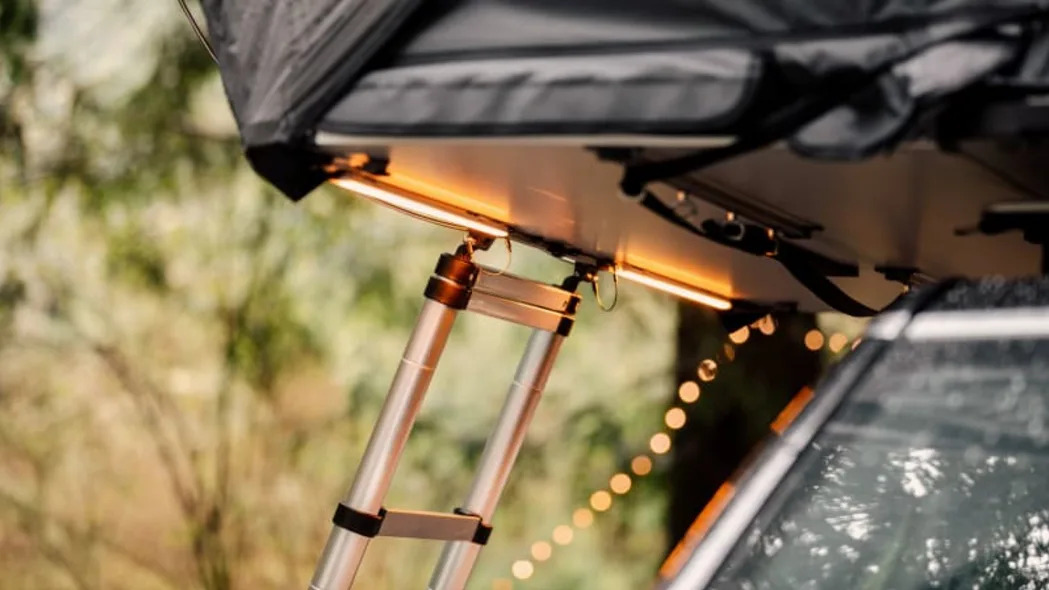
In terms of comfort, iKamper says the Skycamp DLX doesn’t disappoint with its 4-inch self-inflating foam mattress, promising ease of setup alongside substantial comfort enhancements compared to traditional camping setups. Including a natural cork lining is a nod to sustainability, providing waterproof, thermal, and noise-insulating properties to the sleeping quarters.
Structural integrity is also key in the Skycamp DLX’s design, which features a robust aluminum honeycomb base and insulated low-profile shell, crafted to offer durability across varied environmental conditions. The tent’s design optimizes living space without compromising the ease of transport—attributes that facilitate extended adventures in the wilderness.
The model is available in two sizes: the larger four-person Skycamp DLX and the more compact two-person Skycamp DLX Mini priced at $5,150 and $4,450 respectively. Both are engineered for year-round use, highlighting their versatility and appeal to serious campers seeking reliable, all-season equipment.
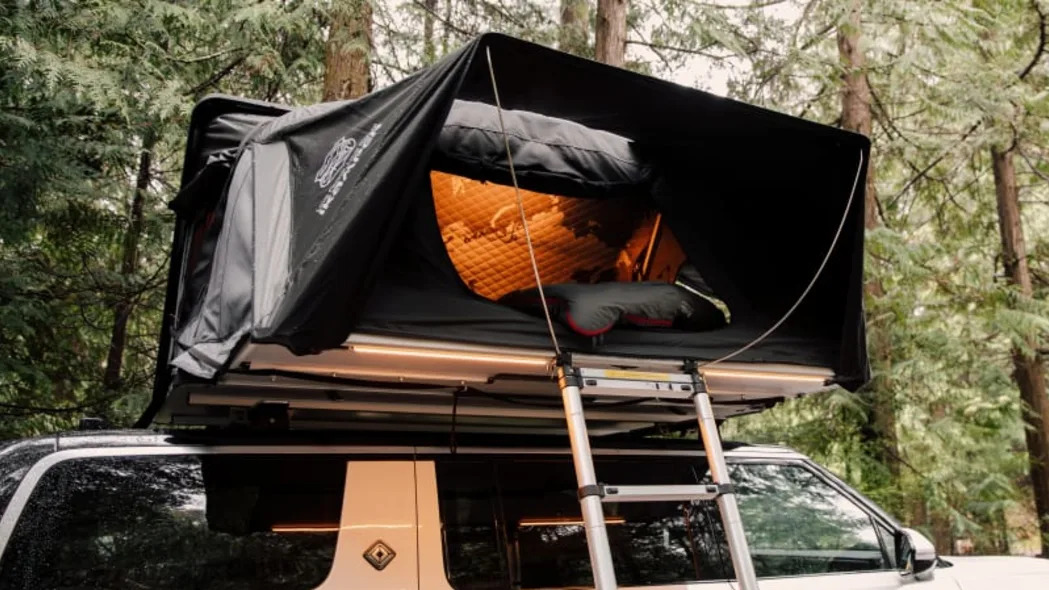
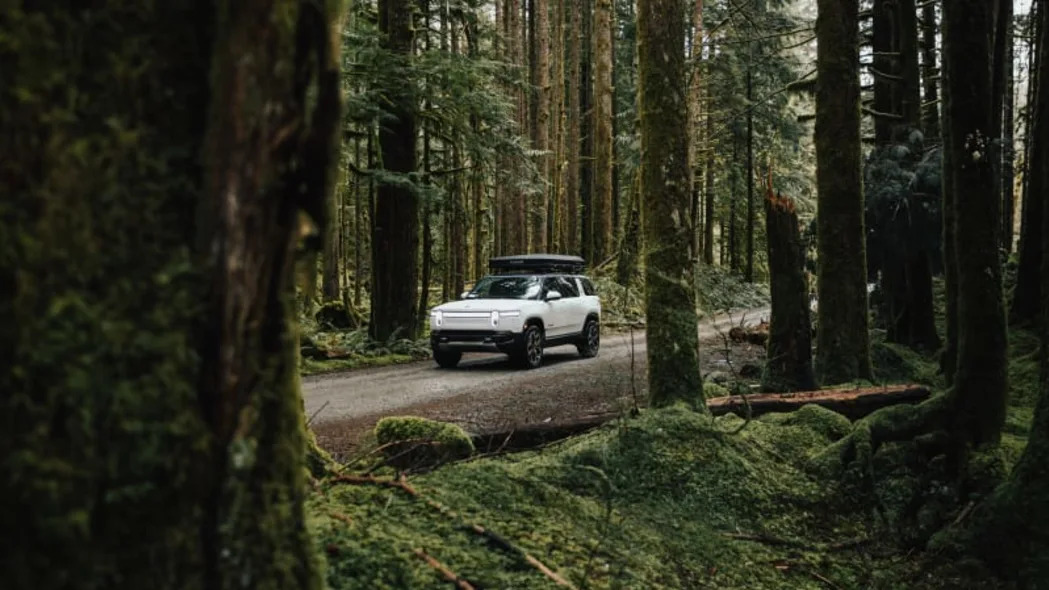
·
این خودرو درحال حاضر گران ترین، لوکس ترین و البته مجهزترین محصول مدیران خودرو به حساب می آید. مشتریان علاقه مند به آریزو 6 جی تی می توانند این خودرو را به صورت نقد و اقساط خریداری کنند. – بزرگ ترین وجه تمایز آریزو 6 جی تی در مقایسه با آریزو 5 اسپرت و آریزو 6 پرو، مشخصات فنی آن است.
منبع خبر: ایرانی روز
دسته بندی خبر: اقتصادی